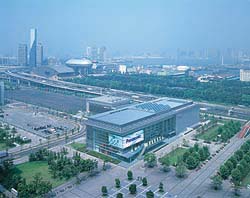Homemaking on the fly
Back to Contents of Issue: November 2002
|
|
|
|
by By Shinichi Terada |
|
 AYAKA YADA, 34, WHO works for a publishing company, says she suffers occasional pangs of guilt when she feels she is sacrificing her family for her work. She faces a difficult question: "How can I prepare dinner according to schedule and spend more time with my family while excelling at my job?" AYAKA YADA, 34, WHO works for a publishing company, says she suffers occasional pangs of guilt when she feels she is sacrificing her family for her work. She faces a difficult question: "How can I prepare dinner according to schedule and spend more time with my family while excelling at my job?"The Panasonic Center may be able to help -- at least in a few years. One of the missions of the center is to create a "ubiquitous network" in which information will be available at your fingertips anytime, anywhere. In other words, Yada may be able to start dinner while still at the office. The center opened in September 2002 in the Ariake district of Tokyo Waterfront City. The center was built with two themes in mind: One is to create the ubiquitous network featuring state-of-the-art home electronic appliances, and the other is "coexistence with the environment," where solar and wind power are used to generate electric power. What makes the Panasonic Center unique is that its exhibitions are virtual products. Some may never be for sale; others may change the way we live. These virtual products, whatever their fate, spark our imagination about what sort of world lies ahead in the near future. Panasonic Center's senior managing director Osamu Tanaka says that the center is a place to solve the digital divide in our lives by listening to visitors' opinions. "We put more emphasis on feedback from customers to make our products better," Tanaka says. "We can create a new lifestyle together." On the second floor, the center exhibits home appliances designed for the near future -- meaning they will be made available commercially in 2005 to 2010. These appliances include an automatic rice cooker, a refrigerator wired to the Internet and a toilet that gives users an automatic health check-up. The Panasonic Center may be a little heavy-handed in its plans for future families. It envisions people retiring to the bedroom, not the living room, at the end of the day, where they will stretch out on the bed, read stories to their children and possibly doze off. If one of them does fall asleep, the high-tech bed has sensors that detect the sleeper's position and try to make the person as comfortable as possible. The bed can store information about the positions in which family members tend to sleep and help create those positions at bedtime. Also, the bed has a function at the head that emits negative ions to relax people. "It's not only a place to sleep; it's also a place to relax together and strengthen family ties," Yada says. In the center, the Internet refrigerator, a microwave oven and a rice cooker are built into the kitchen wall to provide more space. The microwave oven can download software for cooking and the refrigerator automatically dispenses rice and water. Ideally, those electrical home appliances will be connected to your cellphone. You push one button on your cellphone and order the automatic rice cooker to prepare cooked rice for dinner. That way, when you get home, the rice is waiting for you. Also, the refrigerator has a camera inside so you can see what you have to buy before going home. You can also survey your home remotely through a camera on your robotic cleaner. "Even if I have to work overtime, I can treat my family to a tasty meal just by one button on my cellphone," Yada says with a smile. The staff in the center says these products are not ready for practical use yet but they give people an idea of what's to come. John Scott, a 34-year-old engineer, says that Japan can expect to see more dazzling change in information technology. "I am just amazed by Japanese high technology," Scott says. "I am sure I will see those appliances somewhere very soon." The center consists of four stories: The first floor features a digital network displaying products such as cellphones and laptop computers by Panasonic, a room with the latest Nintendo games and a broadband cafe; the second floor has the home appliance mentioned earlier; on the third floor, a corporation backed by Hayashibara Museum of Natural Sciences in Okayama prefecture, Dinosaur FACTory, exhibits fossil specimens. Visitors can experience the process of studying dinosaur fossils with the aid of a PDA and Bluetooth technology. The fourth floor offers business space for enterprises or local governments. @ |
|
Note: The function "email this page" is currently not supported for this page.





